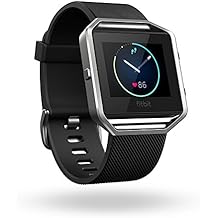There are no affiliate links in this post. :)
As a teacher, I always thought I did a pretty good job at staying active in my classroom. After all, I walk around constantly! When I started counting my steps using my Fitbit Charge HR, I quickly realized that I wasn't doing quite as well as I anticipated. On average I was getting only 5,000 - 6,000 steps during the school day. Studies say we should be getting around 10,000 steps a day!
I started tracking my health and fitness more consciously using my watch. Just wearing the watch and checking the stats encouraged me to get those 10,000 steps each day and I even started to monitor my nutrition using the app! Several of my teacher friends have different types of fitness trackers. We compared notes and came up with a list of the best fitness trackers for teachers, in our humble opinions. :)
Fitbit Charge 2 Heart Rate +
I have the first version of the Fitbit Charge and I love that this watch tracks my heart rate and monitors my cardio workouts and calories burned. It's so gratifying to watch the app track my caloric intake vs. calories burned so that I can better monitor my nutrition. The Fitbit Charge 2 adds guided breathing sessions (definitely need those some days...right, my friends?) and call, text and calendar alerts. I think I'll definitely be upgrading soon - there are so many beautiful colors! I especially love the teal one. (Unless one of these other trackers catch my eye!)
Apple Smart Watch
 The sleek design of the Apple Watches are sooooo pretty. Several of my teacher friends can't imagine living without their watch now that they own one. It's a little pricier than the Fitbit smart watch, but if you're looking for a device that can do double-duty as a sport watch and all-in-one wearable tech, this is for you. It's even water-resistant up to 50 meters! One teacher said she is obsessed with the daily activity tracker which uses sleek, multi-colored rings to help you monitor your daily progress. Click here to learn more from Apple!
The sleek design of the Apple Watches are sooooo pretty. Several of my teacher friends can't imagine living without their watch now that they own one. It's a little pricier than the Fitbit smart watch, but if you're looking for a device that can do double-duty as a sport watch and all-in-one wearable tech, this is for you. It's even water-resistant up to 50 meters! One teacher said she is obsessed with the daily activity tracker which uses sleek, multi-colored rings to help you monitor your daily progress. Click here to learn more from Apple!Garmin Vivosmart HR+
 One of my friends runs several times a week and swears by the Garmin products. She loves the app interface that tracks steps, sleep, "active calories" (calories burned) along with a wide range of ways to monitor nutrition (calories consumed, remaining, etc). There's also a GPS within the watch which allows the wearer to measure distance and pace easily. Click here to learn more about the Garmin Vivosmart HR+.
One of my friends runs several times a week and swears by the Garmin products. She loves the app interface that tracks steps, sleep, "active calories" (calories burned) along with a wide range of ways to monitor nutrition (calories consumed, remaining, etc). There's also a GPS within the watch which allows the wearer to measure distance and pace easily. Click here to learn more about the Garmin Vivosmart HR+.Fitbit Blaze
 The Fitbit Blaze has a very Apple Watch-type feel with a focus on tracking fitness over other apps. It's been described as a "powerhouse" for tracking activities and getting notifications from smartphones. The screen has a beautiful, clear display with touchscreen functionality and (much to my friend's delight!) the battery usually lasts here 4-5 days! Having one last thing to remember during the school week is a lifesaver. The watch keeps careful track of steps, calories burned, etc. so you can just live your life. Click here to check it out for yourself!
The Fitbit Blaze has a very Apple Watch-type feel with a focus on tracking fitness over other apps. It's been described as a "powerhouse" for tracking activities and getting notifications from smartphones. The screen has a beautiful, clear display with touchscreen functionality and (much to my friend's delight!) the battery usually lasts here 4-5 days! Having one last thing to remember during the school week is a lifesaver. The watch keeps careful track of steps, calories burned, etc. so you can just live your life. Click here to check it out for yourself!
While this certainly isn't a comprehensive list of all smart watches available, these represent options that are both affordable and well-recommended! Having a fitness watch has made me more aware about the decisions I make on a day-to-day basis regarding food and exercise. Some of my students love to ask me how many steps I've taken at different times of the day and we can compare our mileage if they happen to be wearing one, too!
If you own a fitness watch that's not on this list and love it, please share it in the comments below! :)

















